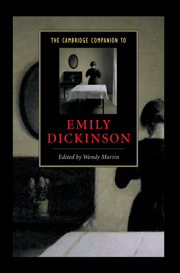3 - Susan and Emily Dickinson
their lives, in letters
from Part 1 - Biography and publication history
Published online by Cambridge University Press: 28 May 2006
Summary
She [Lavinia Dickinson] feels a little baffled by my possession of so many mss. of Emily’s.
– Susan Dickinson to William Hayes Ward, editor of The Independent, 14 March 1891
The first poem “To Sue” is beautiful. I could have wept over it. Some are rather obscure – I must read them many times.
Such genius and mysticism as Emily possessed often transcends mortal comprehension.
– Kate Anthon, long-time friend of Susan and Emily, to Martha Dickinson Bianchi upon publication of The Single Hound, “a volume offered as a memorial to the love of these ‘Dear, dead Women,’” in 1914
. . .Do you remember what whispered to “Horatio”?
Emily to Susan Dickinson, spring 1886, within weeks of Emily’s death. As Hamlet lay dying, he whispered “Report me and my cause aright” and “tell my story” to Horatio. (OMC 253)
During the first century of public distribution of her literary work, many facts about Emily Dickinson's writing practices and about her decades-long alliance with her sister-in-law, Susan Huntington Gilbert Dickinson, have become clearer. As her poems moved from manuscript and hand circulation to printed volumes and various editions, tools such as Thomas H. Johnson's variorum The Poems of Emily Dickinson (1955), his three-volume The Letters of Emily Dickinson (1958) with Theodora Ward, Jay Leyda's two-volume Years and Hours of Emily Dickinson (1960), R. W. Franklin's two-volume The Manuscript Books of Emily Dickinson (1981), and his three-volume variorum The Poems of Emily Dickinson (1998) have proved indispensable for Dickinson scholars.
- Type
- Chapter
- Information
- The Cambridge Companion to Emily Dickinson , pp. 51 - 74Publisher: Cambridge University PressPrint publication year: 2002
- 5
- Cited by



